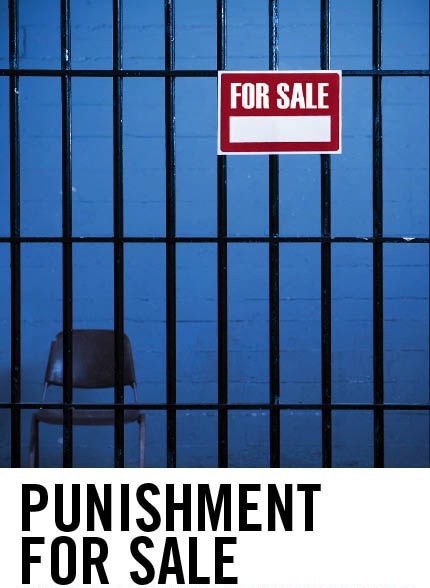
RELATED: Investigators are working to discover the extent of the alleged scheme after finding more than 50 Social Security cards, power of attorney documents and other such forms. The suspects may have been taking in the downtrodden and disabled for their Social Security checks, then holding them captive in wretched conditions without enough to eat or drink, police say. MORE
RELATED: By the end of 2010, the United States was home to 25 percent of the world’s inmates, with roughly 2.4 million people behind bars and over seven million under “correctional supervision.” In any given year, 13 million people pass through the U.S. detention system, which includes federal and state facilities; Native American, juvenile,  military and local jails; U.S. detention centres overseas and holding centres operated by Immigration and Customs Enforcement (ICE). In her book ‘The New Jim Crow: Mass Incarceration in the Age of Colorblindness’, Michelle Alexander writes that even with crime rates on the decline, the U.S. prison population quintupled in just two decades, between 1980 and 2010. It would seem that the case for reducing incarceration rates could not be stronger – especially for taxpayers and state and federal governments. However, one group of people has a vested interest in keeping prisons as full as possible – the private prison corporations and their shareholders.
military and local jails; U.S. detention centres overseas and holding centres operated by Immigration and Customs Enforcement (ICE). In her book ‘The New Jim Crow: Mass Incarceration in the Age of Colorblindness’, Michelle Alexander writes that even with crime rates on the decline, the U.S. prison population quintupled in just two decades, between 1980 and 2010. It would seem that the case for reducing incarceration rates could not be stronger – especially for taxpayers and state and federal governments. However, one group of people has a vested interest in keeping prisons as full as possible – the private prison corporations and their shareholders.
According to a recent report by the Justice Policy Institute, the U.S.’s two largest private prison companies – Corrections Corporation of America (CCA) and GEO Group – pocketed collective annual revenues of 2.9 billion dollars at the close of 2010. The report, called ‘Gaming the System’, also found that since 2000, the number of prisoners held in private federal facilities increased by 120 percent, while those detained in private state facilities shot up by 33 percent – even though the same time period showed a mere 16 percent increase in the total prison population. The report states, “While private prison companies may try to present themselves as just meeting existing ‘demand’ for prison beds and responding to current ‘market? conditions, in fact they have worked hard over the past decade to create markets for their product… As revenues of private prison companies have grown over the past decade, the companies have had more resources with which to build political power, and they have used this power to promote policies that lead to higher rates of incarceration.”
Prison corporations make no secret of their strictly business approach to the justice system or the victims of its harsh penalties. CCA’s 2010 annual report states categorically that, “The demand for our facilities and services could be adversely affected by the relaxation of enforcement efforts, leniency in conviction or parole standards and sentencing practices or through the decriminalization of certain activities that are currently proscribed by our criminal laws – for instance, any changes with respect to drugs and controlled substances or illegal immigration could affect the number of persons arrested, convicted, and sentenced, thereby potentially reducing demand for correctional facilities to house  them.” MORE
them.” MORE
RELATED: But private prison companies are only the most visible component of the increasing corporatization of punishment. Government contracts to build prisons have bolstered the construction industry. The architectural community has identified prison design as a major new niche. Technology developed for the military by companies like Westinghouse is being marketed for use in law enforcement and punishment. Moreover, corporations that appear to be far removed from the business of punishment are intimately involved in the expansion of the prison industrial complex. Prison construction bonds are one of the many sources of profitable investment for leading financiers such as Merrill Lynch. MCI charges prisoners and their families outrageous prices for the precious telephone calls which are often the only contact prisoners have with the free world.
Many corporations whose products we consume on a daily basis have learned that prison labor power can be as profitable as third world labor power exploited by U.S.-based global corporations. Both relegate formerly unionized workers to joblessness and many even wind up in prison. Some of the companies that use prison labor are IBM, Motorola, Compaq, Texas Instruments, Honeywell, Microsoft, and Boeing. But it is not only the hi-tech industries that reap the profits of prison labor. Nordstrom department stores sell jeans that are marketed as “Prison Blues,” as well as t-shirts and jackets made in Oregon prisons. The advertising slogan for these clothes is “made on the inside to be worn on the outside.” Maryland prisoners inspect glass bottles and jars used by Revlon and Pierre Cardin, and schools throughout the world buy graduation caps and gowns made by South Carolina prisoners.
“For private business,” write Eve Goldberg and Linda Evans (a political prisoner inside the Federal Correctional Institution at Dublin, California) “prison labor is like a pot of gold. No strikes. No union organizing. No health benefits, unemployment insurance, or workers’ compensation to pay. No language barriers, as in foreign countries. New leviathan prisons are being built on thousands of eerie acres of factories inside the walls. Prisoners do data entry for Chevron, make telephone reservations for TWA, raise hogs, shovel manure, make circuit boards, limousines, waterbeds, and lingerie for Victoria’s Secret — all at a fraction of the cost of `free labor.'” MORE
for Chevron, make telephone reservations for TWA, raise hogs, shovel manure, make circuit boards, limousines, waterbeds, and lingerie for Victoria’s Secret — all at a fraction of the cost of `free labor.'” MORE
BARRONS: AMERICA HAS 5% OF THE PLANET’S POPULATION, but 25% of its prisoners. A long stay in prison, according to an industry joke, cures very little except heterosexuality. Yet our prison population has more than tripled over the past quarter-century, jumping from roughly 700,000 in 1984 to 2.38 million this year, the fastest pace of any country on earth. Proponents say that incarceration protects society from dangerous offenders, acts as a deterrent and allows re-education, thus fulfilling the criminal justice system’s three main goals of prevention, punishment and rehabilitation. As a result, our federal prisons are at 137% of capacity, and state jails have shot past 110%. (It should be noted that prison populations of some nations, such as China, are held somewhat in check by the government’s willingness to execute people for crimes that would rate only a prison term stateside.) A study by the Pew Center on the States points to an arresting development in the land of the free: For the first time, one in every 100 adults is behind bars, and state funds spent annually on corrections have swelled from $10.6 billion in 1987 to $44 billion. While the Department of Justice says violent crime has declined since 1993, drug arrests and reported crimes have increased. MORE
RELATED: More black men are behind bars or under the watch of the criminal justice system than there were enslaved in 1850, according to the author of a book about racial discrimination and criminal justice. MORE
RELATED: FOR-PROFIT DUNGEONS: Why The Prison-Industrial Complex Will Never Allow Marijuana To Be Legalized

Today we saw an ad on the side of a SEPTA bus advertising a service from Just Talk Communications [screen grab from their web site above] that enables you to receive collect calls from inmates in prison. The ‘you’ is presumably family, friends or lovers, as well as ‘business associates.’ Just Talk would argue that they are providing a valuable service, facilitating communication between prisoners and their loved ones, which may well be true, but we cannot help but feel profoundly bummed that it’s come to this: that incarceration has become such an integral and permanent fixture of life for an ever-expanding segment of society that whole cottage industries have sprung up to profit from this sad and deeply cynical new reality. When imprisoning people becomes a profit center, the only way to increase profits is to find ways to put more people in prison for the long as possible.
RELATED: The Philadelphia Prison System Is Violent, Predatory And Deeply Corrupt Because Nobody Is Watching
